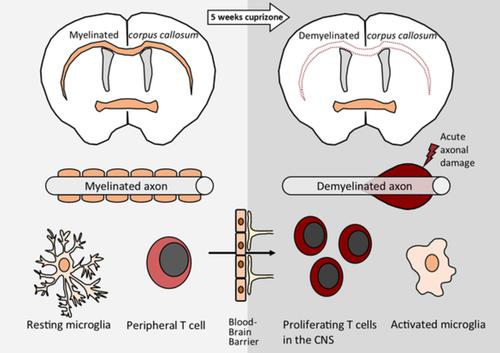Our official English website, www.x-mol.net, welcomes your
feedback! (Note: you will need to create a separate account there.)
Cuprizone‐induced demyelination triggers a CD8‐pronounced T cell recruitment
Glia ( IF 5.4 ) Pub Date : 2020-11-27 , DOI: 10.1002/glia.23937 Hannes Kaddatz 1 , Sarah Joost 1 , Julia Nedelcu 1, 2 , Uta Chrzanowski 1, 2 , Christoph Schmitz 2 , Stefan Gingele 3 , Viktoria Gudi 3 , Martin Stangel 3 , Jiangshan Zhan 1 , Emily Santrau 1 , Theresa Greiner 1 , Julia Frenz 1 , Brigitte Müller-Hilke 4 , Michael Müller 4 , Sandra Amor 5, 6 , Paul van der Valk 5 , Markus Kipp 1
Glia ( IF 5.4 ) Pub Date : 2020-11-27 , DOI: 10.1002/glia.23937 Hannes Kaddatz 1 , Sarah Joost 1 , Julia Nedelcu 1, 2 , Uta Chrzanowski 1, 2 , Christoph Schmitz 2 , Stefan Gingele 3 , Viktoria Gudi 3 , Martin Stangel 3 , Jiangshan Zhan 1 , Emily Santrau 1 , Theresa Greiner 1 , Julia Frenz 1 , Brigitte Müller-Hilke 4 , Michael Müller 4 , Sandra Amor 5, 6 , Paul van der Valk 5 , Markus Kipp 1
Affiliation

|
The loss of myelinating oligodendrocytes is a key characteristic of many neurological diseases, including Multiple Sclerosis (MS). In progressive MS, where effective treatment options are limited, peripheral immune cells can be found at the site of demyelination and are suggested to play a functional role during disease progression. In this study, we hypothesize that metabolic oligodendrocyte injury, caused by feeding the copper chelator cuprizone, is a potent trigger for peripheral immune cell recruitment into the central nervous system (CNS). We used immunohistochemistry and flow cytometry to evaluate the composition, density, and activation status of infiltrating T lymphocytes in cuprizone‐intoxicated mice and post‐mortem progressive MS tissues. Our results demonstrate a predominance of CD8+ T cells along with high proliferation rates and cytotoxic granule expression, indicating an antigenic and pro‐inflammatory milieu in the CNS of cuprizone‐intoxicated mice. Numbers of recruited T cells and the composition of lymphocytic infiltrates in cuprizone‐intoxicated mice were found to be comparable to those found in progressive MS lesions. Finally, amelioration of the cuprizone‐induced pathology by treating mice with laquinimod significantly reduces the number of recruited T cells. Overall, this study provides strong evidence that toxic demyelination is a sufficient trigger for T cells to infiltrate the demyelinated CNS. Further investigation of the mode of action and functional consequence of T cell recruitment might offer promising new therapeutic approaches for progressive MS.
中文翻译:

Cuprizone 诱导的脱髓鞘触发 CD8 发音的 T 细胞募集
髓鞘少突胶质细胞的丧失是许多神经系统疾病的关键特征,包括多发性硬化症 (MS)。在进行性 MS 中,有效的治疗选择有限,外周免疫细胞可以在脱髓鞘部位找到,并建议在疾病进展过程中发挥功能性作用。在这项研究中,我们假设由喂养铜螯合剂铜酮引起的代谢性少突胶质细胞损伤是外周免疫细胞募集到中枢神经系统 (CNS) 的有效触发因素。我们使用免疫组织化学和流式细胞术来评估铜宗中毒小鼠和死后进行性 MS 组织中浸润 T 淋巴细胞的组成、密度和活化状态。我们的结果表明 CD8 +T 细胞以及高增殖率和细胞毒性颗粒表达,表明铜宗中毒小鼠的 CNS 存在抗原和促炎环境。发现在铜宗中毒小鼠中募集的 T 细胞数量和淋巴细胞浸润的组成与进行性 MS 病变中发现的相当。最后,通过用拉喹莫德治疗小鼠来改善铜宗诱导的病理,显着减少了募集的 T 细胞数量。总体而言,这项研究提供了强有力的证据,表明毒性脱髓鞘是 T 细胞浸润脱髓鞘的 CNS 的充分触发因素。进一步研究 T 细胞募集的作用方式和功能后果可能为进行性 MS 提供有希望的新治疗方法。
更新日期:2020-11-27
中文翻译:

Cuprizone 诱导的脱髓鞘触发 CD8 发音的 T 细胞募集
髓鞘少突胶质细胞的丧失是许多神经系统疾病的关键特征,包括多发性硬化症 (MS)。在进行性 MS 中,有效的治疗选择有限,外周免疫细胞可以在脱髓鞘部位找到,并建议在疾病进展过程中发挥功能性作用。在这项研究中,我们假设由喂养铜螯合剂铜酮引起的代谢性少突胶质细胞损伤是外周免疫细胞募集到中枢神经系统 (CNS) 的有效触发因素。我们使用免疫组织化学和流式细胞术来评估铜宗中毒小鼠和死后进行性 MS 组织中浸润 T 淋巴细胞的组成、密度和活化状态。我们的结果表明 CD8 +T 细胞以及高增殖率和细胞毒性颗粒表达,表明铜宗中毒小鼠的 CNS 存在抗原和促炎环境。发现在铜宗中毒小鼠中募集的 T 细胞数量和淋巴细胞浸润的组成与进行性 MS 病变中发现的相当。最后,通过用拉喹莫德治疗小鼠来改善铜宗诱导的病理,显着减少了募集的 T 细胞数量。总体而言,这项研究提供了强有力的证据,表明毒性脱髓鞘是 T 细胞浸润脱髓鞘的 CNS 的充分触发因素。进一步研究 T 细胞募集的作用方式和功能后果可能为进行性 MS 提供有希望的新治疗方法。











































 京公网安备 11010802027423号
京公网安备 11010802027423号